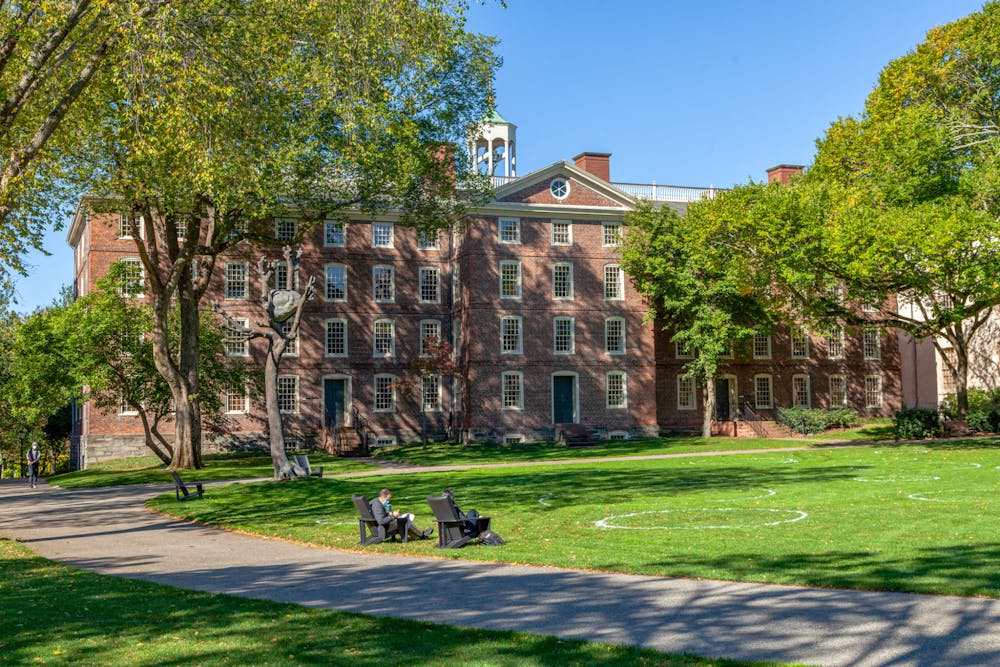With 80 acres of grass and athletic fields, 11 acres of walkways, 13 acres of parking lots and nearly seven acres of shrubs and beds, maintaining Brown’s College Hill campus is no small task. But day and night, a dedicated team is on the job: the Department of Facilities Management Division 5, the University’s groundskeeping crew.
Brown’s groundskeeping division comprises more than 20 groundskeepers, including a mechanic and an ice rink crew leader who oversees Meehan Auditorium’s ice skating rink, said Grounds Superintendent Nicholas Mol. The groundskeeping crew handles a wide range of responsibilities, including managing trees, removing leaves and snow, supporting events and maintaining campus-wide irrigation system, said Mol.
“We always want our best foot forward,” said Mol, who worked in the groundskeeping division for nine years as an assistant superintendent before becoming the superintendent last year. Mol attributes the success of his team to a “very devoted and very hardworking” staff.
“What you see (around campus) is not possible without them,” he added.
Some of the biggest challenges of the job, Mol said, are staying “two steps ahead” of the seasons and large campus events. Right now, groundskeepers are busy with collecting and removing leaves — every year the groundskeeping division donates between 60 and 80 tons of leaves to local farms, which use the leaves for mulch and other purposes, Mol said. The groundskeeping team is also anticipating snow removal by preparing all of its equipment for winter use, he added.
Mol emphasized that the groundskeeping division “always want(s) this campus to be presented at its best.” But its biggest weekend of the year comes during Commencement — “the Super Bowl” for Mol’s team.
Every year, the groundskeeping crew works hard to prepare campus for commencement festivities, including restoring the Main Green after the damage it sustains from Spring Weekend, Mol said. Groundskeepers reseed, fertilize, aerate and sometimes close down high-traffic areas of the Green to rejuvenate the grass in the roughly four weeks between the two events.
Michael Martin, one of the three leadmen who manage the groundskeeping crew, said the groundskeeping team comes together to clean up campus after other large events, such as the annual campus dance or sports events like football games at Brown Stadium.
But according to Mol, students should not worry so much about their impact on the grounds. “That’s what we're paid to do,” Mol said. “You enjoy yourselves here (and) focus on your studies. Don't worry about the turf.”
The work of the groundskeeping team is also at the mercy of the environment, Mol said. Rainy conditions can make grounds maintenance more difficult, and the team changes its treatment plans, such as fertilization schedules, based on upcoming forecasts. “Weather drives our job everyday,” he said.
According to Mol, the groundskeeping crew divides the College Hill campus into 10 different zones, with each groundskeeper assigned to a specific zone. This allows each groundskeeper to “learn their zone” and its dynamics, Mol said, such as which parts are most highly trafficked and require special attention.
Mark Lindenberg, the division’s arborist and another leadman, was formerly in charge of the Sciences Library zone, and he “knew everything that (happened) within that area,” he said.
The zone encompassing the athletics complex is assigned five groundskeepers because of its more complicated environment, Mol said. Typical duties of athletics groundskeepers include “lining or painting of fields” and “clay infield maintenance,” while seasonal duties also require “setting up and breaking down the Pizzitola (Sports Center) gymnasium for basketball, wrestling, volleyball” and other events, according to the Facilities Management website.
For Mol, the ever-changing nature of the job is one of the things he enjoys most about it. Fluctuating weather and unexpected obstacles often force him to scrap any plans he makes for the day. “You’re constantly on your toes, (and) no days are the same,” he said. “There’s always a new challenge.”
The strength of Mol’s team means no challenge is too great, he said. The groundskeeping team has “a passion for what they do, they take a lot of pride in what they do (and) they're very good at what they do,” Mol said.
Some groundskeepers have worked at the University for several decades and are veterans in grounds maintenance, Mol explained. Lindenberg earned his Bachelor of Science in turf management and worked on golf courses before starting at Brown 20 years ago. Martin started working in parks at the age of 14 and has been at Brown for 34 years, serving for the past 20 as a leadman.
In their years at the University, Lindenberg and Martin have witnessed many changes to campus, such as the addition of several new buildings to campus. “The campus is so much more beautiful now than it was (because) we keep improving on it,” Lindenberg said.
Martin agreed, emphasizing just how much crew’s equipment has improved during his tenure. Whereas the team used to have “loaders with no cabs” and tractors with no internal heating mechanisms, they now have access to “top-notch” equipment, Martin said.
Despite the job’s challenges, both Lindenberg and Martin said they love their team and their work. “This is the best job of all time,” Lindenberg said. “Because this is the kind of job where we work in such a beautiful environment. I mean, what environment is better than this?”
Martin said that everyone on the team calls him Smiley, because he always smiles while tending to the grounds. “It’s just a great place to work,” he said.
“It’s the kind of job you don’t hate coming in on Monday for,” Lindenberg added.

Sam Levine is a University News editor from Brooklyn, New York covering on-campus activism. He is a senior concentrating in International and Public Affairs.





